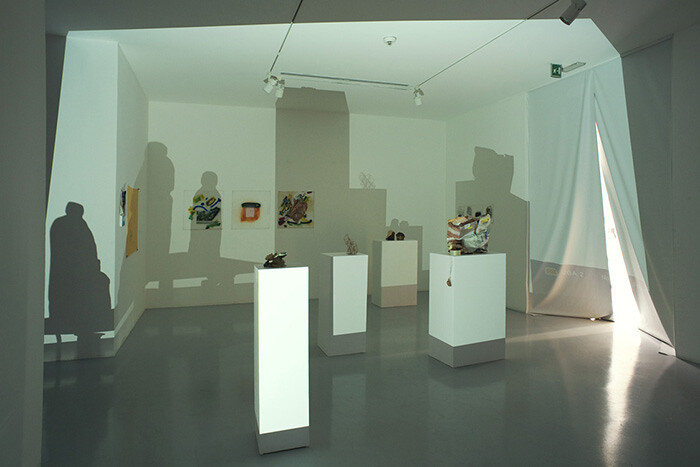“Free Internet,” Trisha Baga’s exhibition at Giò Marconi, is a scrappy, energetic, stoned out tour de force in visual stimulation. Behind 3D glasses, your eyes have to move fast in order to focus on her continuous ping-pong of vacillating images: floating slices of salami, overlapping images, bats in caves, cats at night, partying animals, icons jumping at you, and internet search results with keywords like, “where is my vagina?”—which immediately reminded me of artist Nam June Paik’s 1962 hand-scrawled composition Danger Music for Dick Higgins: “Creep into the VAGINA of a living WHALE.”(1) Sounds, glitches, radio feeds, samples of laughter, and songs contribute to the work’s overall synesthesia. It’s like browsing through a chronology of fragments of “reality,” or whatever that means in the age of the Oculus Rift.
And indeed, once inside the show, “Is this real?” becomes a persistent question. This must be—to borrow the term from art historian Michael Baxandall—our “period eye.” Baxandall first introduced this term in 1972 to characterize the impact of cultural factors on our ways of processing visual data and understanding pictures.(2) He argued, for instance, that during the Renaissance both painters and public embraced geometric perspective at a time when merchants and bankers increasingly practiced arithmetic and calculations. What we might have in the mid-twentieth century called the “Pop eye,” British artist Richard Hamilton (1922–2011) unwittingly pinpointed in 1956 as something that made “today’s homes so different, so appealing.” The current sexiness of all things post-internet chronicles the advent of another shift, based on the habit of mediating one’s presence, identity, experiences, and attention deficits. In fact, this tendency is no longer the exclusive privilege of artistic derives, like the Bolex diaries of New York-based filmmaker Jonas Mekas, to name but one significant example. Artists like Baga are finding new ways of solving the old problem of how to engage and include the viewer within the space of representation.
“Free Internet,” a constellation of over twenty works (including 2D and 3D video projections, sculptures, paintings, installations, collages, and tapestries), plays the immersion card. It includes a generous amount of hi-tech devices—which Baga has in passing compared to “one of those update alerts on your PC”—as well as loads of objects made from paper, ceramics, papier mâché, and foam. Slick projectors join forces with flashlights with failing batteries, so that the show gives the impression of having set foot in two different time frames, past and present. Just like we all do. This fluid, mixed-media approach brought Baga (who first cut her teeth in New York, studying at Cooper Union and Bard College, and then opening her first solo show in 2012 at the Whitney Museum of American Art) to the forefront of exhibitions such as last year’s Lyon Biennale or last fall’s “Speculations on Anonymous Materials” exhibition at the Fridericianum in Kassel.
Yet, there’s nothing less anonymous than Baga’s heaps of “materials”: the images and objects she employs are often self-made in collaboration with her family and friends; the artist also regularly performs in her works in multiple, coexisting versions and personae (here, also with moustaches and beards). The first room opens with a group of sculptures set on plinths and cast with colored, theatrical lightning—including Ear, One Girl, Frequent Flyer (all works 2014). Carbon 14, a geometrical cluster of painted toothpicks, references the scientific method for calculating time and life spans by means of progressive decay. “SO, if you had a salami that had 10% carbon-14 compared to a living sample, then that fossil would be T equals…line…oh, god,” says the voiceover in Baby, a large 3D video projection in an adjacent room, complete with striped deck chairs in which you can sit down, relax, and enjoy.
Baga builds a web of cross-references and exercises in perception, repetition, and difference: in the sculpture Pizza POV, real slices of salami are pinned to a wall above a carpet topped with ceramic objects; in Salami Display, 3D digital versions of salami are projected onto painted foam like spots; and in Salami Diamond, the slices are projected as big as planets in a darkened room. In Sand right outside my door, the artist brings us to her studio, where she’s painting while her dog sniffs around and tries to devour every image (3D and otherwise) in sight. Time flies, as the “love clock” on Baby’s wall reminds us, and scenes shot in London, New York, Florida, and in a cave from one of Baga’s recent professional stays in Puerto Rico flash by (amongst the most recognizable characters in the video are naked members of the Vienna-based collective gelitin).
On the opposite side of the gallery, Baga turns the imposing main room into her own version of a dark cave. There are wires and projectors, as well as a number of manipulated objects across a series of works—including Mouth, a room-size installation with rocking chairs-cum-stereo system; Guano, a multi-piece sculpture with flashlights directed at small mirrors that light up into temporary moons; and the 3D video installation Twin’s Party with recorded party scenes repeating at short intervals like in a sports instant replay. Baga toys with Plato’s allegory of the cave, whose prisoners can not only see shadows, but also imagine grasping the objects and forms that cast them, so that appearances might be mistaken for reality. Very appropriate, I guess, for an artist who describes her practice as a way to “guide phenomenological compositions about the acts of looking and recognizing, and the gap in between.”(3)
1) Nam June Paik, “Danger Musik for Dick Higgins,” in Notations, ed. John Cage (New York: Something Else Press, 1969), not paginated [207]. 2) As Baxandall writes, “A picture is sensitive to the kinds of interpretive skill—patterns, categories, inferences, analogies—the mind brings to it.” See Michael Baxandall, Painting and Experience in Fifteenth Century Italy: A Primer in the Social History of Pictorial Style (Oxford: Oxford University Press, 1974), 34. 3) Trisha Baga, “About”: http://bagalab.biz/work/About.html.










